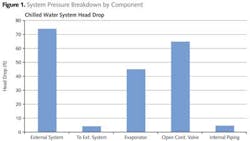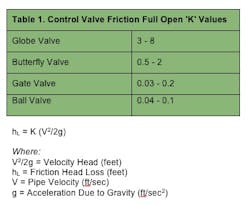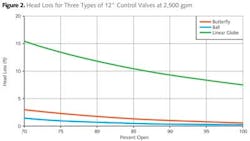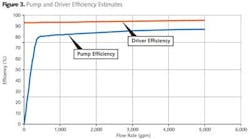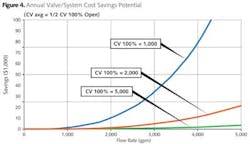As stated above, the pressure drop and energy cost for a control valve can be sizable, especially for high flow rate systems, and/or high specific speed pumps.
Valve Coefficient (CV)
The pressure drop for a valve is not normally given in terms of its "K" value but instead the "CV" coefficient is normally used to convey this energy loss. The CV flow coefficient is the flow rate that will cause a 1 psid pressure drop across the valve. Thus, the lower the valve CV value, the higher the pressure drop for a given flow rate. The formula is:
CV = Q / (dP)0.5
Where:
dP = (Q / CV)2
Q = Flow Rate (gpm)
dP = Pressure Drop (psi) |
The valve CV can also be determined, given the valve "K" coefficient by using the following formula:
CV = 29.9 * D2 / K0.5
Where:
D = Inside Pipe Diameter (inch) |
Control valves are often offered with different trims, which can change the 100% open CV values and the shape of the CV characteristic (CV vs. percent valve opening). Actual valve CV values can be obtained from the valve manufacturer or from field tests.
Valve Selection Issues
Once the control valve type and CV value have been determined, there are other valve issues that should be considered, some of which also impact the pump system efficiency:
- Size
- Pressure rating
- CV flow characteristics (curve shape)
- Trim
- Stem sealing
- Material
- Actuator, pneumatic, stepping motor, solenoid, geared motor, electro-hydraulic
- Control
- Intelligent positioners
Valve Energy Cost Estimates
In order to determine the true energy lost across a control valve, the efficiency of the pump (which creates the pressure) and the driver (which powers the pump) must also be considered. The formulas for the energy lost across a control valve using the valve CV coefficient then become:
HPVALVE = Q3 / 1714 / (CV)2 / EFFP
KW (IN) = 0.7457 * HP / EFFD
COST ($) = $.05/KW-HR * KW * HR |
In order to use these formulas we need to make certain assumptions, such as the pump efficiency, driver efficiency, energy cost, operating hours, and the amount of control valve throttling. For an example, we have made the following assumptions (if actual values are available, these factors should be adjusted accordingly):
- Energy Cost = $.05/kW/hr
- Operating Hours = 8,760 (full time)
- Pump Efficiency = Maximum, Hydraulic Institute double suction, 1,500 Ns (see Fig. 3)
- Drive Efficiency = Standard "as-new" motor efficiency (see Fig. 3)
- Valve Opening = 50% of Maximum (full open) CV
